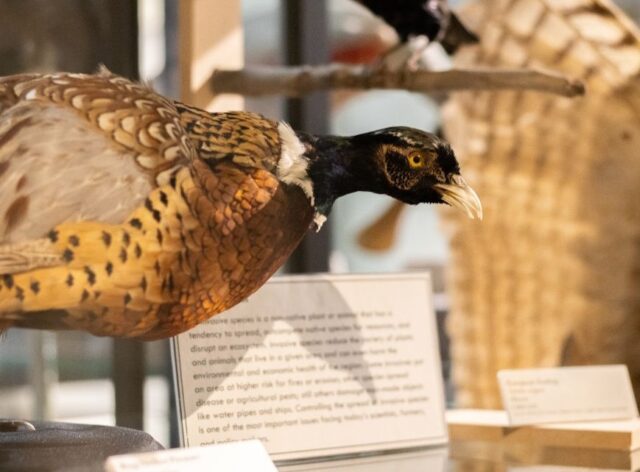Beecher Collections Laboratory

Get a glimpse behind the scenes with scientists, volunteers, and more in the Beecher Lab.
- Time of Year
- Year Round
- Location
- Level 2
This unique space highlights how scientific specimens are prepared and displayed as a part of our collection. Not only do these specimens add entertainment and enjoyment to our exhibit experiences, they are also critically important for education and conservation research.
The lab design allows visitors to observe different elements of curatorial work that the public doesn’t normally get to see, such as specimen preparation (including taxidermy), insect pinning, and botanical preparation. Learn about our scientific collections and the processes involved in maintaining these collections directly from our Collections staff and volunteers themselves! Plus, explore unique pieces from our collection via themed displays.
Access to this exhibit is included with Museum admission.
A Closer Look
Is It Real?
When visitors walk through our exhibits, a question they often ask is, “Are the taxidermied animals real?” While we do have some animal models that are man-made, the vast majority of our exhibits showcase real specimens. They are no longer living, but they are real.
We use real specimens in two ways: for exhibits throughout the museum building and for research in our scientific collections. Specimens mounted for exhibit are called “display mounts,” while research specimens are referred to as “study skins.” Whether we are creating a display mount or a study skin, a lot of work goes into properly preserving the specimen to ensure that it will last for future generations to see.

An example of a display mount

An example of a study skin
First, we have to record the specimen’s data. When processing a specimen destined for scientific use, we must record: where it came from; when it was collected and by whom; and various measurements, including the specimen’s individual body parts and appendages.
Next, we have to carefully remove the specimen’s skin. When preserving birds, some wing, foot, and skull bones may be left attached to the skin because the features, foot scales, or beak material would otherwise be lost. In mammals, however, no bones are left in the skin. Once the skin is separated from the body, we are left with two parts: the skin and the carcass that includes the bones, muscles, and internal organs. We then apply chemicals to the skin that will turn it to leather. This is called “tanning.”
Next, we have to create an internal support for the skin. A specimen that will be used in a diorama needs to have a lot of anatomical detail and a lively pose, something that reflects how you might see the animals in its natural habitat. To do this, we create a mannequin that reflects the species’ internal anatomy. A study specimen, on the other hand, doesn’t require all of this detail, and has less complicated internal support.

Now it’s time to “taxi” the “dermy,” or move the skin! This step takes skill and time as the taxidermist aligns the skin with the mannequin and adheres it in place. Careful sewing hides the stitches while the feathers or fur are groomed into the final position. During mounting, display mounts require additional steps such as installing glass eyes, sculpting faces, and painting exposed skin to restore the species’ natural color.
Finally, the specimen is then dried over the next several days or weeks. A display mount specimen will then be mounted on a base that may include preserved plants and artificial soil, while a study skin will be put in a Cornell box or on display in a vitrine.
Keep Exploring
Natural history museums have a wide variety of specimens in their collections. From birds to mammals and everything in between! In order to preserve and protect them, a lot of care goes into preparing and storing them. Dawn, our senior director of collections, is explaining how we preserve our natural history collections in this episode of Curious By Nature!
Still curious about taxidermy? Get a closer look with this special episode of The Brain Scoop with Emily Graslie filmed at the Nature Museum! Content warning: this video contains footage of specimen dissection and preservation.





